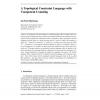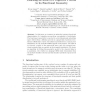274 search results - page 14 / 55 » A Functional Language for Logarithmic Space |
ICFP
2008
ACM
14 years 8 months ago
2008
ACM
Severely resource-constrained devices present a confounding challenge to the functional programmer: we are used to having powerful ion facilities at our fingertips, but how can we...
JANCL
2002
13 years 7 months ago
2002
A topological constraint language is a formal language whose variables range over certain subsets of topological spaces, and whose nonlogical primitives are interpreted as topologi...
FGR
2011
IEEE
12 years 11 months ago
2011
IEEE
— Common human actions are instantly recognizable by people and increasingly machines need to understand this language if they are to engage smoothly with people. Here we introdu...
IPMI
2011
Springer
12 years 11 months ago
2011
Springer
In this paper we construct an atlas that captures functional characteristics of a cognitive process from a population of individuals. The functional connectivity is encoded in a lo...
CEFP
2005
Springer
14 years 1 months ago
2005
Springer
This chapter describes Hume: a functionally-based language for programming with bounded resource usage, including time and space properties. The purpose of the Hume language design...


